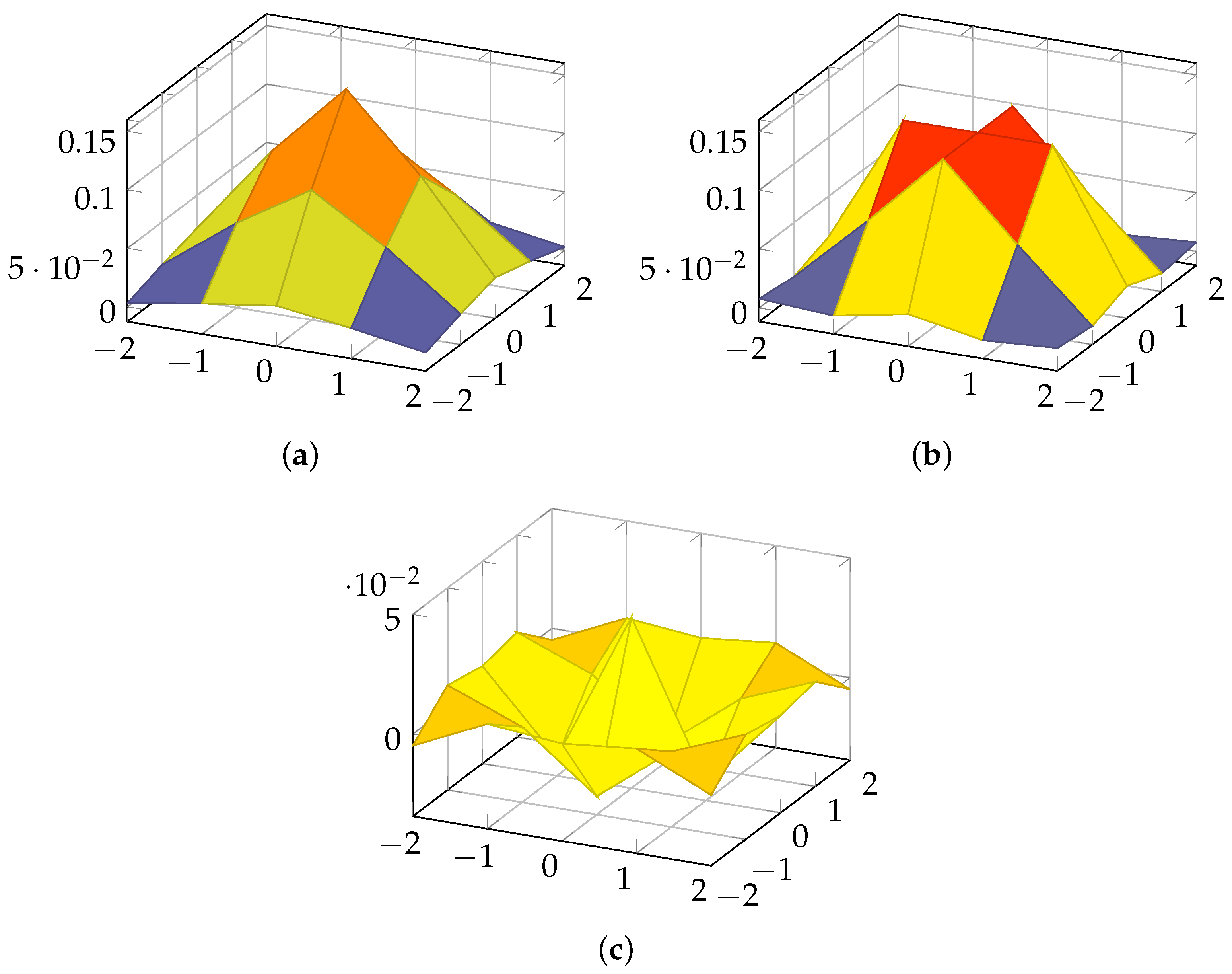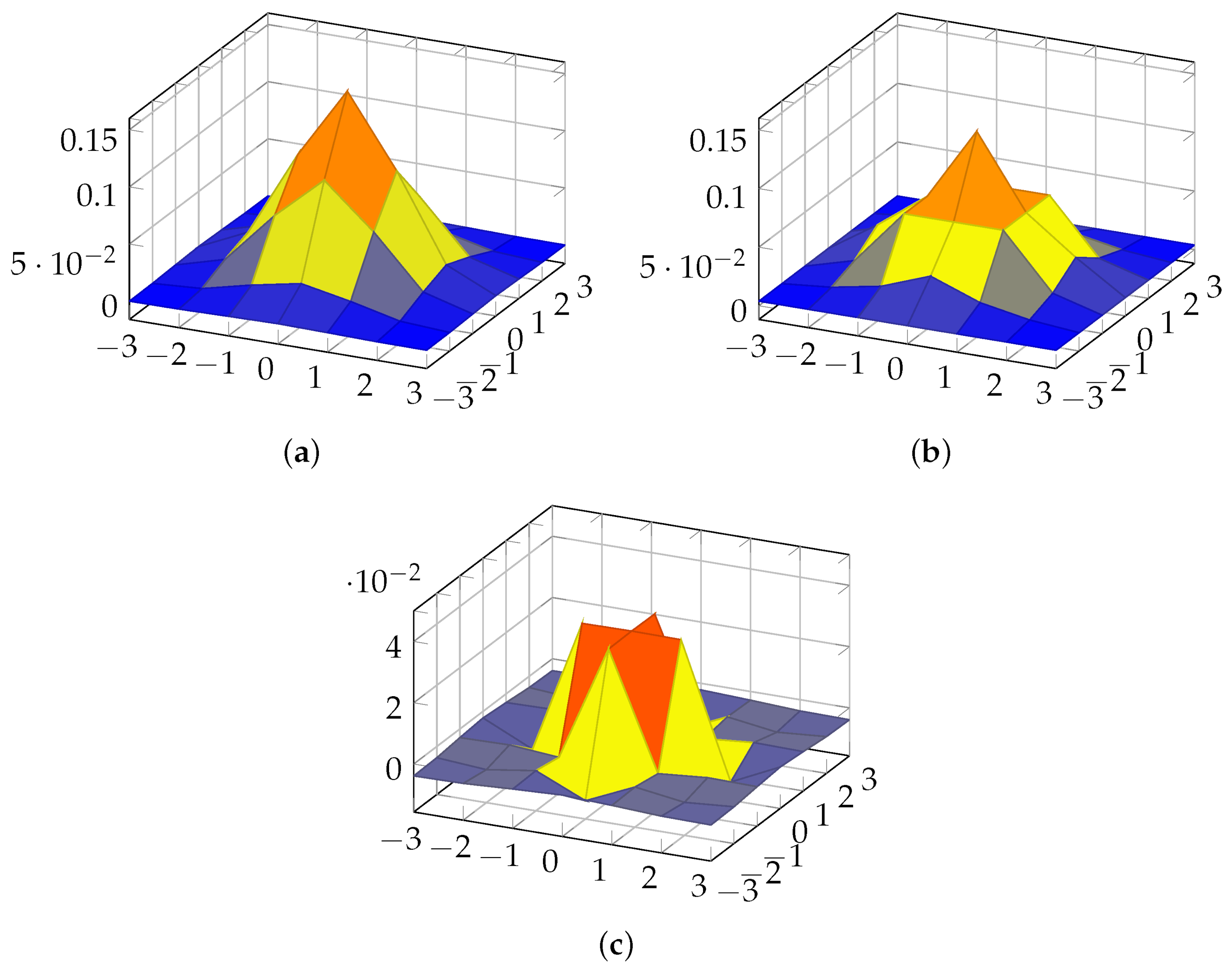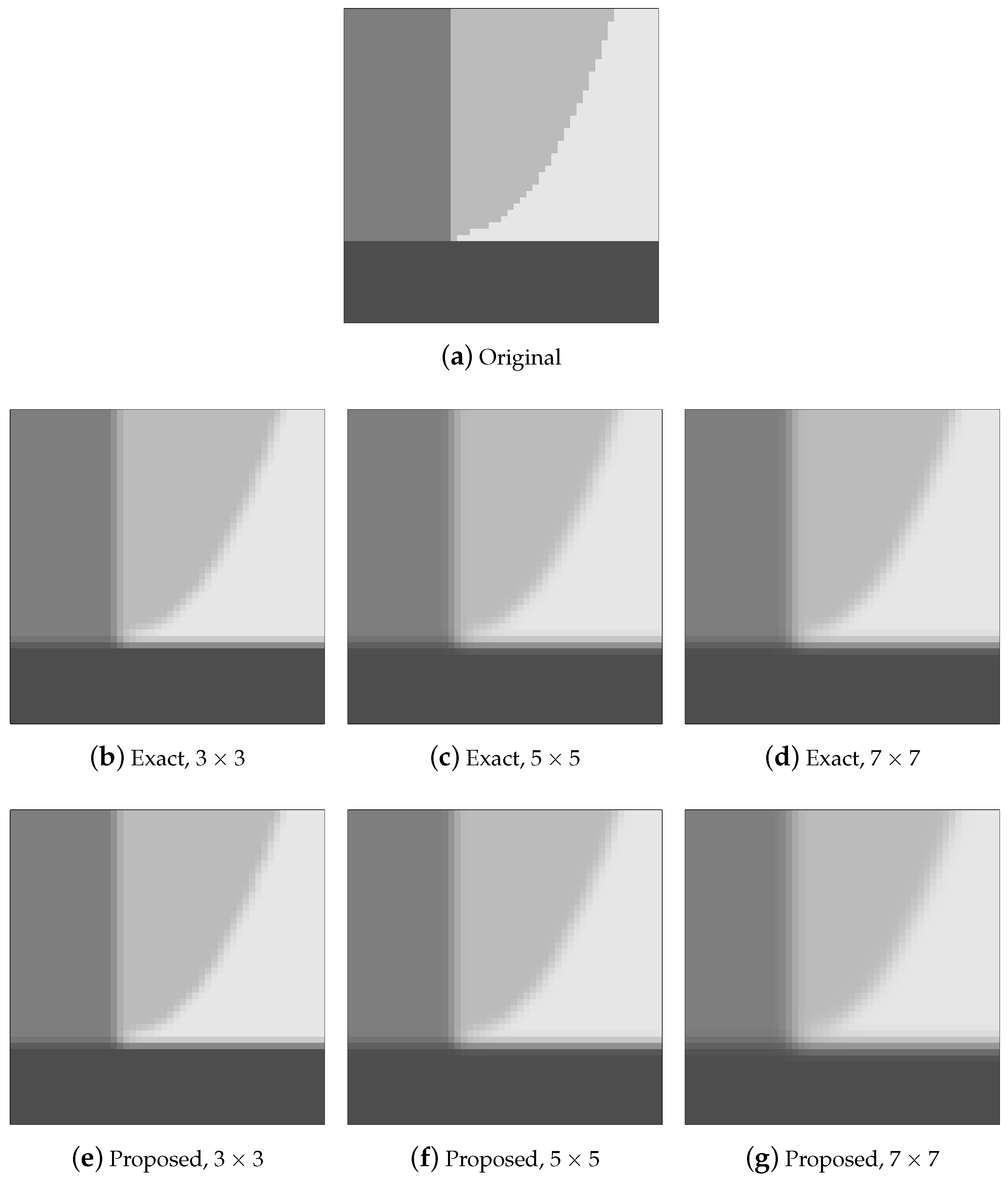Gaussian Kernel Approximations Require Only Bit-Shifts
Abstract
1. Introduction
- Provide a method for obtaining 2D Gaussian filter approximations for any odd integer kernel size, based on binary integer programming methods;
- Derive a mathematical formalism capable of suitably approximating each Gaussian kernel filter coefficient to a single negative power of two, which requires only one bit-shifting operation to be implemented in hardware;
- Demonstrate the suitability of the approximate kernels in the context of image filtering;
- Analyze the complexity and performance of the proposed method according to its hardware realization compared to competing methods archived in the literature.
2. Approximate Gaussian Kernel
2.1. Definitions and Design Criteria
- Req. 1.
- The approximate filter coefficients must be trivial multiplicands [35];
- Req. 2.
- The arithmetic operation counts (number of bit-shifting operations and additions) for the approximate filter coefficient representation must be minimal;
- Req. 3.
- The distance between the exact and approximate filters must be minimized according to an energy-based measure;
- Req. 4.
- The resulting filter must possess unitary gain to preserve the average intensity of processed data [29];
- Req. 5.
- The symmetry of the exact Gaussian kernel must be transferred to its approximate counterpart.
2.2. Optimization Framework
- Due to Req. 4, we haveTherefore, the above equation can be re-cast in suitable terms for the optimization problem as the following constraint:
- Req. 5 imposes the natural symmetry structure of the original exact 2D Gaussian filter to the approximate candidate solutions. Therefore, the sought optimal solution must satisfy the following condition. Ifthenfor and .
3. Results and Analyses
3.1. Particular Solutions
3.2. Computational Complexity Analysis
3.3. Image Processing Experimental Analysis
3.3.1. Blurring Experiment: Relative Measurements
3.3.2. Blurring Experiment: Absolute Measurements
3.3.3. Edge Detection Experiment
4. VLSI Architectures
4.1. FPGA Realization
4.2. Performance Measurements
5. Discussion
5.1. Mathematical Formalism and Design Criteria
5.2. Complexity Analysis and Image Experiments
5.3. Hardware Realization
Final Remarks and Recommendations
6. Conclusions
Author Contributions
Funding
Institutional Review Board Statement
Informed Consent Statement
Data Availability Statement
Conflicts of Interest
References
- Szeliski, R. Computer Vision: Algorithms and Applications; Springer: Berlin/Heidelberg, Germany, 2010. [Google Scholar]
- Jain, A.K. Fundamentals of Digital Image Processing; Prentice-Hall, Inc.: Englewood Cliffs, NJ, USA, 1989. [Google Scholar]
- Gonzalez, R.C.; Woods, R.E. Digital Image Processing; Pearson: Essex, UK, 2018. [Google Scholar]
- Duda, R.O.; Hart, P.E. Pattern Classification and Scene Analysis; Wiley Interscience, Inc.: New York, NY, USA, 1973. [Google Scholar]
- Burger, W.; Burge, M.J. Principles of Digital Image Processing; Springer: Hagenberg, Austria; Washington, DC, USA, 2008. [Google Scholar] [CrossRef]
- Deng, H.; Clausi, D.A. Gaussian MRF rotation-invariant features for image classification. IEEE Trans. Pattern Anal. Mach. Intell. 2004, 26, 951–955. [Google Scholar] [CrossRef] [PubMed]
- Greenspan, H.; Belongie, S.; Goodman, R.; Perona, P. Rotation invariant texture recognition using a steerable pyramid. In Proceedings of the 12th International Conference on Pattern Recognition, Jerusalem, Israel, 9–13 October 1994; Volume 2, pp. 162–167. [Google Scholar]
- Tzagkarakis, G.; Beferull-Lozano, B.; Tsakalides, P. Rotation-invariant texture retrieval with gaussianized steerable pyramids. IEEE Trans. Image Process. 2006, 15, 2702–2718. [Google Scholar] [CrossRef] [PubMed]
- Tzagkarakis, G.; Beferull-Lozano, B.; Tsakalides, P. Rotation-Invariant Texture Retrieval via Signature Alignment Based on Steerable Sub-Gaussian Modeling. IEEE Trans. Image Process. 2008, 17, 1212–1225. [Google Scholar] [CrossRef]
- Ohbuchi, R.; Furuya, T. Scale-weighted dense bag of visual features for 3D model retrieval from a partial view 3D model. In Proceedings of the IEEE 12th International Conference on Computer Vision (ICCV) Workshops, Kyoto, Japan, 27 September–4 October 2009; pp. 63–70. [Google Scholar]
- Nasrollahi, K.; Moeslund, T. Super-resolution: A comprehensive survey. Mach. Vis. Appl. 2014, 25, 1423–1468. [Google Scholar] [CrossRef]
- Irani, M.; Peleg, S. Super resolution from image sequences. In Proceedings of the 10th International Conference on Pattern Recognition Proceedings, Atlantic City, NJ, USA, 16–21 June 1990; Volume 2, pp. 115–120. [Google Scholar]
- Li, S.; Hao, Q.; Kang, X.; Benediktsson, J.A. Gaussian Pyramid Based Multiscale Feature Fusion for Hyperspectral Image Classification. IEEE J. Sel. Top. Appl. Earth Obs. Remote Sens. 2018, 11, 3312–3324. [Google Scholar] [CrossRef]
- Baker, S.; Kanade, T. Super-Resolution: Reconstruction or Recognition? In Proceedings of the IEEE-EURASIP Workshop on Nonlinear Signal and Image Processing, Baltimore, MD, USA, 3–6 June 2001. [Google Scholar]
- Baker, S.; Kanade, T. Limits on Super-Resolution and How to Break Them. IEEE Trans. Pattern Anal. Mach. Intell. 2002, 24, 1167–1183. [Google Scholar] [CrossRef]
- Baker, S.; Kanade, T. Hallucinating faces. In Proceedings of the Fourth IEEE International Conference on Automatic Face and Gesture Recognition, Grenoble, France, 28–30 March 2000; pp. 83–88. [Google Scholar]
- Rawash, Y.Z.; Al-Naami, B.; Alfraihat, A.; Owida, H.A. Advanced Low-Pass Filters for Signal Processing: A Comparative Study on Gaussian, Mittag-Leffler, and Savitzky-Golay Filters. Math. Model. Eng. Probl. 2024, 11, 1841–1850. [Google Scholar] [CrossRef]
- Suryanarayana, G.; Chandran, K.; Khalaf, O.I.; Alotaibi, Y.; Alsufyani, A.; Alghamdi, S.A. Accurate Magnetic Resonance Image Super-Resolution Using Deep Networks and Gaussian Filtering in the Stationary Wavelet Domain. IEEE Access 2021, 9, 71406–71417. [Google Scholar] [CrossRef]
- Mora, J.P.; Bedle, H.; Marfurt, K.J. Fault enhancement using probabilistic neural networks and Laplacian of a Gaussian filter: A case study in the Great South Basin, New Zealand. Interpretation 2022, 10, SC1–SC15. [Google Scholar] [CrossRef]
- Ali, U.; Lee, I.H.; Mahmood, M.T. Guided image filtering in shape-from-focus: A comparative analysis. Pattern Recognit. 2021, 111, 107670. [Google Scholar] [CrossRef]
- Wei, Z.; Yan, Q.; Lu, X.; Zheng, Y.; Sun, S.; Lin, J. Compression Reconstruction Network with Coordinated Self-Attention and Adaptive Gaussian Filtering Module. Mathematics 2023, 11, 847. [Google Scholar] [CrossRef]
- Lee, J.; Yun, J.; Lee, J.; Hwang, I.; Hong, D.; Kim, Y.; Kim, C.G.; Park, W. An Effective Algorithm and Architecture for the High-Throughput Lossless Compression of High-Resolution Images. IEEE Access 2019, 7, 138803–138815. [Google Scholar] [CrossRef]
- Kim, J.; Kyung, C. A Lossless Embedded Compression Using Significant Bit Truncation for HD Video Coding. IEEE Trans. Circuits Syst. Video Technol. 2010, 20, 848–860. [Google Scholar]
- Choi, J. Review of low power image sensors for always-on imaging. In Proceedings of the 2016 International SoC Design Conference (ISOCC), Jeju, Republic of Korea, 23–26 October 2016; pp. 11–12. [Google Scholar]
- Venkateshbabu, S.; Ravichandran, C.G. Low power accuracy substitution circuit for image processing application. In Proceedings of the 2017 International Conference on IoT in Social, Mobile, Analytics and Cloud (I-SMAC), Palladam, India, 10–11 February 2017; pp. 275–279. [Google Scholar]
- Noraky, J.; Sze, V. Low power depth estimation for time-of-flight imaging. In Proceedings of the 2017 IEEE International Conference on Image Processing (ICIP), Beijing, China, 17–20 September 2017; pp. 2114–2118. [Google Scholar]
- Taher, F.; Zaki, A.; Elsimary, H. Design of low power FPGA architecture of image unit for space applications. In Proceedings of the IEEE 59th International Midwest Symposium on Circuits and Systems (MWSCAS), Abu Dhabi, United Arab Emirates, 16–19 October 2016; pp. 1–4. [Google Scholar]
- Turcza, P.; Duplaga, M. Hardware-Efficient Low-Power Image Processing System for Wireless Capsule Endoscopy. IEEE J. Biomed. Health Inform. 2013, 17, 1046–1056. [Google Scholar] [CrossRef]
- Khorbotly, S.; Hassan, F. A modified approximation of 2D Gaussian smoothing filters for fixed-point platforms. In Proceedings of the 2011 IEEE 43rd Southeastern Symposium on System Theory, Auburn, AL, USA, 14–16 March 2011; pp. 151–159. [Google Scholar]
- Garg, B.; Sharma, G.K. A quality-aware Energy-scalable Gaussian Smoothing Filter for image processing applications. Microprocess. Microsyst. 2016, 45, 1–9. [Google Scholar] [CrossRef]
- Cabello, F.; León, J.; Iano, Y.; Arthur, R. Implementation of a fixed-point 2D Gaussian Filter for Image Processing based on FPGA. In Proceedings of the 2015 Signal Processing: Algorithms, Architectures, Arrangements, and Applications (SPA), Poznan, Poland, 23–25 September 2015; pp. 28–33. [Google Scholar]
- Lee, A.; Ahmadi, M.; Jullien, G.A.; Miller, W.C.; Lashkari, R.S. Digital filter design using genetic algorithm. In Proceedings of the IEEE Symposium on Advances in Digital Filtering and Signal Processing, Victoria, BC, Canada, 5–6 June 1998; pp. 34–38. [Google Scholar]
- Williams, C.S. Designing Digital Filters; Prentice-Hall, Inc.: Englewood Cliffs, NJ, USA, 1986. [Google Scholar]
- Cintra, R.J.; Bayer, F.M.; Tablada, C.J. Low-complexity 8-point DCT approximations based on integer functions. Signal Process. 2014, 99, 201–214. [Google Scholar] [CrossRef]
- Blahut, R.E. Fast Algorithms for Signal Processing; Cambridge University Press: Cambridge, MA, USA, 2010. [Google Scholar]
- Makhorin, A.O. GNU Linear Programming Kit. Available online: www.gnu.org/software/glpk/ (accessed on 4 July 2024).
- Kuhn, H.W. The Hungarian method for the assignment problem. Nav. Res. Logist. Q. 1955, 2, 83–97. [Google Scholar] [CrossRef]
- Karthik, P.; Tejashwini, N.C. Design and implementation of adaptive Gaussian filters for the removal of salt and pepper noise on FPGA. In Proceedings of the International Conference on Electrical, Electronics, Communication, Computer and Optimization Techniques (ICEECCOT), Mysuru, India, 9–10 December 2016; pp. 53–59. [Google Scholar] [CrossRef]
- Talbi, F.; Alim, F.; Seddiki, S.; Mezzah, I.; Hachemi, B. Separable convolution Gaussian smoothing filters on a Xilinx FPGA platform. In Proceedings of the Fifth International Conference on the Innovative Computing Technology (INTECH 2015), Galcia, Spain, 20–22 May 2015; pp. 112–117. [Google Scholar] [CrossRef]
- Khan, T.M.; Bailey, D.G.; Khan, M.A.U.; Kong, Y. Efficient Hardware Implementation For Fingerprint Image Enhancement Using Anisotropic Gaussian Filter. IEEE Trans. Image Process. 2017, 26, 2116–2126. [Google Scholar] [CrossRef]
- Song, S.; Lee, S.; Ko, J.P.; Jeon, J.W. A hardware architecture design for real-time Gaussian filter. In Proceedings of the IEEE International Conference on Industrial Technology (ICIT), Busan, Republic of Korea, 26 February–1 March 2014; pp. 626–629. [Google Scholar] [CrossRef]
- Joginipelly, A.; Varela, A.; Charalampidis, D.; Schott, R.; Fitzsimmons, Z. Efficient FPGA implementation of steerable Gaussian smoothers. In Proceedings of the 44th Southeastern Symposium on System Theory (SSST), Jacksonville, FL, USA, 11–13 March 2012; pp. 78–82. [Google Scholar] [CrossRef]
- Levitin, A. Introduction to the Design & Analysis of Algorithms, 3rd ed.; Pearson: Boston, MA, USA, 2012. [Google Scholar]
- University of Southern California, Signal and Image Processing Institute. The USC-SIPI Image Database; University of Southern California: Los Angeles, CA, USA, 2011. [Google Scholar]
- Huynh-Thu, Q.; Ghanbari, M. Scope of validity of PSNR in image/video quality assessment. Electron. Lett. 2008, 44, 800–801. [Google Scholar] [CrossRef]
- Wang, Z.; Bovik, A.C.; Sheikh, H.R.; Simoncelli, E.P. Image quality assessment: From error visibility to structural similarity. IEEE Trans. Image Process. 2004, 13, 600–612. [Google Scholar] [CrossRef]
- Kay, S.M. Fundamentals of Statistical Signal Processing: Estimation Theory; Prentice-Hall, Inc.: Upper Saddle River, NJ, USA, 1993; Volume 1. [Google Scholar]
- Xilinx. 7 Series DSP48E1 Slice User Guide; Xilinx: San Jose, CA, USA, 2018. [Google Scholar]
- Bouguezel, S.; Ahmad, M.O.; Swamy, M.N.S. Low-complexity 8×8 transform for image compression. Electron. Lett. 2008, 44, 1249. [Google Scholar] [CrossRef]
- Oliveira, R.S.; Cintra, R.J.; Bayer, F.M.; da Silveira, T.L.T.; Madanayake, A.; Leite, A. Low-complexity 8-point DCT approximation based on angle similarity for image and video coding. Multidimens. Syst. Signal Process. 2019, 30, 1363–1394. [Google Scholar] [CrossRef]






| N | Wordlength | Method | # of Multiplications | # of Additions |
|---|---|---|---|---|
| 3 | 6 | Exact | 9 | 8 |
| Khorbotly–Hassan [29] | 0 | 18 | ||
| Garg–Sharma [30] | 0 | 13 | ||
| Cabello et al. [31] | 0 | 31 | ||
| Proposed | 0 | 8 | ||
| 5 | 8 | Exact | 25 | 24 |
| Khorbotly–Hassan [29] | 0 | 66 | ||
| Garg–Sharma [30] | 0 | 41 | ||
| Cabello et al. [31] | 0 | 76 | ||
| Proposed | 0 | 24 | ||
| 7 | 15 | Exact | 49 | 48 |
| Khorbotly–Hassan [29] | 0 | 180 | ||
| Garg–Sharma [30] | 0 | 77 | ||
| Cabello et al. [31] | 0 | 103 | ||
| Proposed | 0 | 48 |
| N | Wordlength | Method | PSNR | SSIM |
|---|---|---|---|---|
| 3 | 6 | Khorbotly–Hassan [29] | 65.0584 | 0.9997 |
| Garg–Sharma [30] | 57.3749 | 0.9994 | ||
| Cabello et al. [31] | 53.3941 | 0.9984 | ||
| Proposed | 51.9224 | 0.9984 | ||
| 5 | 8 | Khorbotly–Hassan [29] | 66.0763 | 0.9999 |
| Garg–Sharma [30] | 41.8214 | 0.9984 | ||
| Cabello et al. [31] | 50.7928 | 0.9985 | ||
| Proposed | 51.8503 | 0.9981 | ||
| 7 | 15 | Khorbotly–Hassan [29] | 85.2323 | 0.9999 |
| Garg–Sharma [30] | 57.3294 | 0.9991 | ||
| Cabello et al. [31] | 43.4979 | 0.9984 | ||
| Proposed | 50.4509 | 0.9977 |
| N | Method | PSNR | SSIM |
|---|---|---|---|
| 3 | Exact | 25.9539 | 0.99997 |
| Khorbotly–Hassan [29] | 25.9678 | 0.99997 | |
| Garg–Sharma [30] | 25.7377 | 0.99996 | |
| Cabello et al. [31] | 25.9373 | 0.99997 | |
| Proposed | 26.6959 | 0.99997 | |
| 5 | Exact | 25.0316 | 0.99996 |
| Khorbotly–Hassan [29] | 25.0022 | 0.99996 | |
| Garg–Sharma [30] | 24.7035 | 0.99995 | |
| Cabello et al. [31] | 24.9931 | 0.99996 | |
| Proposed | 25.1014 | 0.99996 | |
| 7 | Exact | 24.9563 | 0.99996 |
| Khorbotly–Hassan [29] | 24.9565 | 0.99996 | |
| Garg–Sharma [30] | 24.8965 | 0.99996 | |
| Cabello et al. [31] | 24.8295 | 0.99995 | |
| Proposed | 23.6457 | 0.99994 |
| Metric | Method | |||
|---|---|---|---|---|
| Proposed | Khorbotly–Hassan [29] | Garg–Sharma [30] | Cabello et al. [31] | |
| # Slices | 34 | 32 | 39 | 33 |
| # LUT | 84 | 83 | 106 | 86 |
| # FF | 102 | 84 | 107 | 84 |
| # DSP | 0 | 2 | 0 | 2 |
| (ns) | 3.938 | 4.220 | 3.763 | 5.362 |
| (MHz) | 253.936 | 236.966 | 265.745 | 186.496 |
| (mW MHz−1) | 0.012 | 0.013 | 0.012 | 0.021 |
| Metric | Method | |||
|---|---|---|---|---|
| Proposed | Khorbotly–Hassan [29] | Garg–Sharma [30] | Cabello et al. [31] | |
| # Slices | 92 | 82 | 90 | 80 |
| # LUT | 222 | 221 | 237 | 224 |
| # FF | 305 | 293 | 303 | 295 |
| # DSP | 0 | 2 | 1 | 2 |
| (ns) | 4.208 | 5.801 | 5.405 | 5.888 |
| (MHz) | 237.643 | 172.384 | 185.014 | 169.837 |
| (mW MHz−1) | 0.021 | 0.041 | 0.032 | 0.047 |
| Metric | Method | |||
|---|---|---|---|---|
| Proposed | Khorbotly–Hassan [29] | Garg–Sharma [30] | Cabello et al. [31] | |
| # Slices | 172 | 166 | 157 | 152 |
| # LUT | 446 | 451 | 444 | 383 |
| # FF | 584 | 534 | 536 | 547 |
| # DSP | 4 | 16 | 10 | 5 |
| (ns) | 4.486 | 6.189 | 5.717 | 5.642 |
| (MHz) | 222.916 | 161.577 | 174.917 | 177.242 |
| (mW MHz−1) | 0.031 | 0.105 | 0.052 | 0.051 |
| Metric | Method | |||
|---|---|---|---|---|
| Proposed | Khorbotly–Hassan [29] | Garg–Sharma [30] | Cabello et al. [31] | |
| # Slices | 34 | 33 | 32 | 33 |
| # LUT | 84 | 85 | 83 | 86 |
| # FF | 102 | 84 | 84 | 84 |
| # DSP | 0 | 3 | 2 | 2 |
| (ns) | 3.938 | 5.682 | 4.220 | 5.362 |
| (MHz) | 253.936 | 175.994 | 236.967 | 186.496 |
| (mW MHz−1) | 0.012 | 0.023 | 0.013 | 0.021 |
Disclaimer/Publisher’s Note: The statements, opinions and data contained in all publications are solely those of the individual author(s) and contributor(s) and not of MDPI and/or the editor(s). MDPI and/or the editor(s) disclaim responsibility for any injury to people or property resulting from any ideas, methods, instructions or products referred to in the content. |
© 2024 by the authors. Licensee MDPI, Basel, Switzerland. This article is an open access article distributed under the terms and conditions of the Creative Commons Attribution (CC BY) license (https://creativecommons.org/licenses/by/4.0/).
Share and Cite
Cintra, R.J.; Martinez, P.; Leite, A.; Coutinho, V.A.; Bayer, F.M.; Madanayake, A.; Coelho, D.F.G. Gaussian Kernel Approximations Require Only Bit-Shifts. Information 2024, 15, 618. https://doi.org/10.3390/info15100618
Cintra RJ, Martinez P, Leite A, Coutinho VA, Bayer FM, Madanayake A, Coelho DFG. Gaussian Kernel Approximations Require Only Bit-Shifts. Information. 2024; 15(10):618. https://doi.org/10.3390/info15100618
Chicago/Turabian StyleCintra, R. J., Paulo Martinez, André Leite, Vítor A. Coutinho, Fábio M. Bayer, Arjuna Madanayake, and Diego F. G. Coelho. 2024. "Gaussian Kernel Approximations Require Only Bit-Shifts" Information 15, no. 10: 618. https://doi.org/10.3390/info15100618
APA StyleCintra, R. J., Martinez, P., Leite, A., Coutinho, V. A., Bayer, F. M., Madanayake, A., & Coelho, D. F. G. (2024). Gaussian Kernel Approximations Require Only Bit-Shifts. Information, 15(10), 618. https://doi.org/10.3390/info15100618





